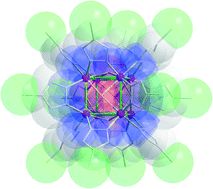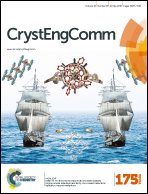Octanuclear Ni(ii) cubes based on halogen-substituted pyrazolates: synthesis, structure, electrochemistry and magnetism†
Abstract
The employment of halogen-substituted pyrazole ligands in nickel(II) clusters afforded three anionic Ni(II) cubes, (HNEt3)2[Ni8(Xpz)12(OH)6] (X = Cl, 1·2CH3CN; X = Br, 2·2CH3CN; X = I, 3·12CH3CN; pz = pyrazolate). Clusters 1–3 are isolated as dianionic compounds which have similar cube geometry with each vertex occupied by a Ni(II) atom and eight μ4-OH− capped on eight square faces. The Xpz ligands adopt a bidentate mode to bind paired Ni(II) atoms on the edge of the cube. Interestingly, the three Ni8 cubes have similar symmetry, size and shape but pack together to form different lattice symmetry, which should be dictated by the halogen-related supramolecular interactions (C–X⋯H, C–X⋯π and X⋯X halogen bonding) in different crystals. The electrochemistry of 1–3 showed a Ni(II)/Ni(I) redox couple with E1/2 at ca. 900 mV and the oxidization potential order is 1 > 3 > 2 depending on the halogen substituents. 1–3 exhibit excellent electrocatalytic performances toward the oxidation of nitrite. The different packing of Ni8 cubes in 1–3 also has an important influence on their magnetic behaviors. Complex 2 showed antiferromagnetic couplings between the Ni(II) ions within the cubes, whereas 1 and 3 exclusively exhibited mixed ferromagnetic and antiferromagnetic properties, leading to frustration and typical spin glass behavior.



 Please wait while we load your content...
Please wait while we load your content...